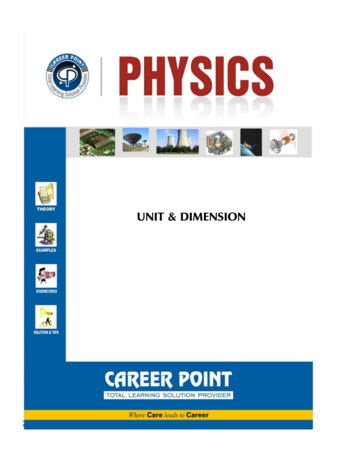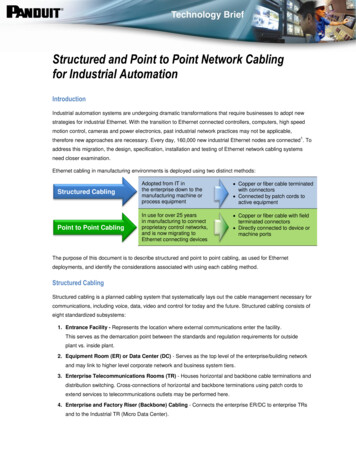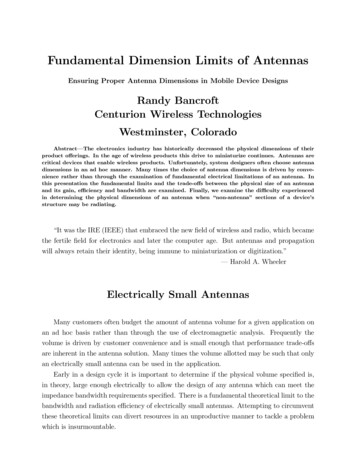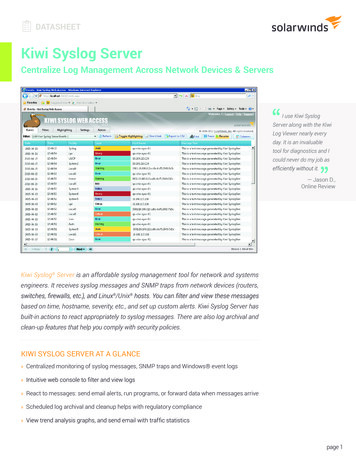
Transcription
UNIT & DIMENSIONCorporate Office: CP Tower, Road No.1, IPIA, Kota (Raj.), Ph: 0744-2434159UNIT & DIMENSION1
UNIT & DIMENSIONPrefaceIIT - JEE Syllabus : Unit & DimensionUnit & Dimensions, Dimensional analysis, Least count, Significant figure, Methods of measurementand Error analysis for physical quantities.Fundamental concepts of the Physics start from this chapter. Basically the terms &concepts which are illustrated in this topic will be used in so many ways because all Physicalquantities have units. It is must to measure all Physical quantities so that we can use them. In thischapter we will have an over view of different units of different Physical quantities. We will learnthe dimension and dependence of the unit of any Physical quantity on fundamental quantities orunit. Entire topic is illustrated very systematically with respective examples so that the studentscan understand the fundamentals very easily & quickly. Students are advised to read every point ofsupplementary very carefully which is given at the end of the topic. Generally, students are notable to find out the Dimension of unseen or new quantity as their basic concepts are not clear &then they read the dimensions like a parrot. It should be avoided & they should develope themselves,so that they can find out the dimensions of any given quantity.Total number of Questions in Units & Dimension are :In chapter Examples. 27Corporate Office: CP Tower, Road No.1, IPIA, Kota (Raj.), Ph: 0744-2434159UNIT & DIMENSION2
Physics :Physics is the study of the laws of nature fromthe observed events.1. PHYSICAL QUANTITIESThe quantities by means of which we describethe laws of physics are called physical quantities.There are two type of physical quantities.1.1 Fundamental quantities1.2 Derived quantities1.1 Fundamental quantities:Physical quantities which are independent of eachother and cannot be further resolved into anyother physical quantity are known as fundamentalquantities. There are seven ty(a) LengthMetrem(b) MassKilogramkg(c) TimeSeconds(d) Electric currentAmpereA(e) ThermodynamicKelvinKtemperature(f) LuminousCandelaCdintensity(g) Amount ofMoleMol.substance1.2 Derived Quantities :Physical quantities which depend uponfundamental quantities or which can be derivedfrom fundamental quantities are known as derivedquantities.2. UNITSDefinition : Things in which quantity is measuredare known as units.Measurement of physical quantity (Magnitude) (Unit)Ex.1A physical quantity is measured and the resultis expressed as nu where u is the unit usedand n is the numerical value. If the result isexpressed in various units then :(A) n size of u (B) n u2(C) n u1(D) n uThere are three types of units2.1 Fundamental or base units2.2 Derived units2.3 Supplementary units2.1 Fundamental or base units:Units of fundamental quantities are calledfundamental units.2.1.1 Characteristics of fundamental units:(i) they are well defined and are of a suitable size(ii) they are easily reproducible at all places(iii) they do not vary with temperature, timepressure etc. i.e. invariable.(iv) there are seven fundamental units.2.1.2 Definitions of fundamental units:2.1.2.1 Metre :The distance travelled by light in Vacuum in1299 ,792 ,458 second is called 1m.2.1.2.2 Kilogram :The mass of a cylinder made of platinum iridiumalloy kept at international bureau of weights andmeasures is defined as 1kg.2.1.2.3 Second :Cesium -133 atom emits electromagnetic radiationof several wavelengths. A particular radiation isselected which corresponds to the transistionbetween the two hyperfine levels of the groundstate of Cs - 133. Each radiation has a timeperiod of repetition of certain characteristics. Thetime duration in 9, 192, 631, 770 time periods ofthe selected transistion is defined as 1s.2.1.2.4 Ampere :Suppose two long straight wires with negligiblecross-section are placed parallel to each other invacuum at a seperation of 1m and electriccurrents are established in the two in samedirection. The wires attract each other. If equalcurrents are maintained in the two wires so thatthe force between them is 2 10–7 newton permeter of the wire, then the current in any of thewires is called 1A. Here, newton is the SI unit offorce.2.1.2.5 Kelvin :1of the thermodynamic273.16temperature of triple point of water is called 1K.The fractionAnswer : (D)Corporate Office: CP Tower, Road No.1, IPIA, Kota (Raj.), Ph: 0744-2434159UNIT & DIMENSION3
2.1.2.6 Mole :The amount of a substance that contains as manyelementary entities (Molecules or atoms if thesubstance is monoatomic) as there are numberof atoms in .012 kg of carbon - 12 is called amole. This number (number of atoms in 0.012 kgof carbon-12) is called Avogadro constant and itsbest value available is 6.022045 x 1023 .independent of temperature. But the lengthof object varies with temperature and is givenby the relation .L t L0 (1 αt) We usually specify the temperature atwhich measurement is made.Ex.42.1.2.7 Candela:The S.I. unit of luminous intensity is 1cd whichis the luminous intensity of a blackbody of1surface aream 2 placed at the600,000temperature of freezing platinum and at a pressureof 101,325 N/m2, in the direction perpendicular toits surface.Examplesbased onEx.2Sol.(A) length ; mass ; velocity(B) length ; time ; velocity(C) mass ; time; velocity(D) length ; time, masslengthi.e. in this set atimequantity is dependent on the other twoquantities Where as fundamental quantitiesare independent.Sol.[B] Since velocity Definition of fundamental UnitsA man seeing a lighting starts countingseconds until he hears thunder. He thenclaims to have found an approximate butsimple rule that if the count of second isdivided by an integer, the result directly givesin km, the distance of the lighting source.What is the integer if the velocity of sound is330 m/sIf n is the integer then according to theproblem dist in km.Which of the following sets cannot enter intothe list of fundamental quantities in anysystem of units2.2 Derived units :Units of derived quantities are called derived units.ΙllustrationPhysical quantityunitsVolume (length)3m3Speed length/time m/s2.3 Supplementary units :The units defined for the supplementary quantitiesnamely plane angle and solid angle are calledthe supplementary units. The unit for plane angleis rad and the unit for the solid angle is steradian.Note :t in s (v) tnn Ex.3Sol.11 3330 x 10 3vIn defining the standard of length we have tospecify the temperature at which themeasurement should be made. Are wejustified in calling length a fundamentalquantity if another physical. quantity,temperature, has to be specified in choosinga standard.Yes, length is a fundamental quantity. Onemetre is the distance that contains1650 763.73 wavelength of orange-red light ofKr - 86. Hence, the standard metre isThe supplemental quantities have only units butno dimensions (will be discussed later)3. PRINCIPAL SYSTEM OF UNITS3.1 C.G.S. system [centimetre (cm) ; gram (g) andsecond (s)]3.2 F.P.S system [foot ; pound ; second]3.3 M.K.S. system [meter ; kilogram ; second]3.4 S.I. (system of international)In 1971 the international Bureau of weight andmeasures held its meeting and decided a systemof units. Which is known as the internationalsystem of units.Corporate Office: CP Tower, Road No.1, IPIA, Kota (Raj.), Ph: 0744-2434159UNIT & DIMENSION4t in sn
Examplesbased on4. DIMENSIONSUnitsEx.5The acceleration due to gravity is 9.80 m/s2.What is its value in ft/s2 ?Sol.Because 1 m 3.28 ft, thereforeDimensions of a physical quantity are the powersto which the fundamental quantities must beraised to represent the given physical quantity.Ι llustration :9.80 m/s2 9.80 3.28 ft/s2Force (Quantity) mass acceleration 32.14 ft/s2Ex.6Sol.A cheap wrist watch loses time at the rate of8.5 second a day. How much time will thewatch be off at the end of a month ? mass lengthvelocity mass ( time) 2time mass length (time)–2Time delay 8.5 s/daySo dimensions of force: 1 in mass 8.5 30 s/ (30 day)1 in length 255 s/month 4.25 min/month.–2 in timeand Dimensional formula : [MLT–2]5. DIMENSIONAL FORMULAIt is an expression which shows how and which of the fundamental units are required to represent the unitof physical quantity.Different quantities with units. symbol and dimensional l bVolumeVl b hVelocityvv Momentumpp mvAccelerationaa ForceImpulseWorkF–WF maF tF. dEnergyKE or UK.E. s t v t1mv22S.I. UnitMetre or m(Metre)2 or m2D.F.M0LT0M0L2T0(Metre)3 or m3M0L3T0m/sM0LT–1kgm/sMLT–1m/s2M0LT–2Newton or NN.secN.mMLT–2MLT–1ML2T–2Joule or JML2T–2watt or WML2T–3kg/m3ML–3T0P.E. mghWtPowerPP Densitydd mass/volumeCorporate Office: CP Tower, Road No.1, IPIA, Kota (Raj.), Ph: 0744-2434159UNIT & DIMENSION5
Pascal or PaN.m.ML–1T–2ML2T–2arcradiusradian or radM0L0T0ω θtrad/secM0L0T–1αα ω trad/sec2M0L0T–2Moment of InertiaII mr2kg-m2ML2T0Angular momentumJ or LJ mvrkgm 2sML2T–1Frequencyν or ff hertz or HzM0L0T–1Stress—F/AN/m2ML–1T–2Strain— l A V;;l AV—-M0L0T0Youngs modulusYY N/m2ML–1T–2Surface tensionTFWorlAN J;m m2ML0T–2Force constant (spring)kF kxN/mML0T–2Coefficient of viscosityη dv F η AdxGravitational constantGF PressureTorquePτP F/Aτ r FAngular displacementθθ Angular velocityωAngular acceleration1TF/A l / l(Bulk modulus)kg/ms(poise in C.G.S)Gm1m2N m2r2kg 2 G ML–1T–1M–1L3T–2Fr 2m1m 2JkgM0L2T–2—Q m S tKelvin or KJoule or CalorieM0L0T0θ 1ML2T–2SQ m S tJoulekg.KelvinM0L2T–2θ–1Latent heatLQ mLJoulekgM0L2T–2Coefficient of thermalKQ Joulem sec KMLT–3θ–1Gravitational potentialVgVg TemperatureHeatθQSpecific heatPEmKA (θ1 θ 2 )tdconductivityCorporate Office: CP Tower, Road No.1, IPIA, Kota (Raj.), Ph: 0744-2434159UNIT & DIMENSION6
Fµ0qπ4Universal gas constantRPV nRTJoulemol.KML2T–2θ–1Mechanical equivalentof heatJW JH—M0L0T0Coulomb or CM0L0TAM0L0T0AQtChargeQ or qI CurrentI—Ampere or AElectric permittivityε01q1q2F 4 πε . 20r(coul.) 2Electric PotentialVV Intensity of electric fieldECapacitance WqC2orN. m 2N m2M–1L–3A2T4Joule/coulML2T–3A–1E N/coul.MLT–3A–1CQ CVFaradM–1L–2T4A2Dielectric constantor relative permittivityεr—M0L0T0ResistanceRεεr ε0V IROhmML2T–3A–2ConductanceSS MhoM–1 L–2T–3A2Specific resistanceρOhm meterML3T–3A–2Mho/meterM–1L–3T3A2Tesla or weber/m2MT–2A–1WeberML2 T–2A–1A/mM0L–1T0A1RRAρ lor resistivityConductivity orσ1σ ρspecific conductanceMagnetic inductionBMagnetic fluxφMagnetic intensityHF qvBsinθor F BILdφe dtB µ HMagnetic permeabilityof free space or mediumµ0B Coefficient of self orMutual inductanceLe L .Electric dipole momentpMagnetic dipole momentMIdl sin θNr2amp2MLT–2A–2HeneryML2T–2A–2p q 2lC.m.M0LTAM NIAamp.m2M0L2AT0dIdtCorporate Office: CP Tower, Road No.1, IPIA, Kota (Raj.), Ph: 0744-2434159UNIT & DIMENSION7
Examplesbased onEx.7Sol.Ex.8Sol.Ex.9Sol.Sol.Dimensions(a) Can there be a physical quantity whichhas no unit and dimensions(b) Can a physical quantity have unit withouthaving dimensions(a) Yes, strain(b) Yes, angle with units radiansFill in the blanks(i) Three physical quantities which have samedimensions are .(ii) Mention a scalar and a vector physicalquantities having same dimensions.(i) Work, energy, torque(ii) Work, torqueChoose the correct statement (s)(A)all quantities may be representeddimensionally in terms of the basequantities(B) all base quantity cannot be representeddimensionally in terms of the rest of thebase quantities(C) the dimension of a base quantity in otherbase quantities is always zero.(D) the dimension of a derived quantity isnever zero in any base quantity.[A,B,C](B) all the fundamental base quantities areindependent of any other quantity(C) same as aboveEx.10 If velocity (V), time (T) and force (F) were chosenas basic quantities, find the dimensions of mass.Sol.Dimensionally :Force mass accelerationForce mass Force timeMass velocityEx.11mass FTV–1In a particular system, the unit of length,mass and time are chosen to be 10cm, 10gmand 0.1s respectively. The unit of force inthis system will be equivalent to1N10(C) 10N(A)DimensionallyF MLT–2In C.G.S system1 dyne 1g 1 cm (1s)–2In new system1x (10g) (10 cm) (0.1s)–2 21dyne1g1cm 10s 1x10g10cm 1s 1 1x10,000104 dyne 1x10 x 105 dyne 1 N1 dyne 1N10Ex.12 If the units of length and force are increasedfour times, then the unit of energy will(A) increase 8 times(B) increase 16 times(C) decreases 16 times(D) increase 4 timesSol.DimensionallyE ML2T–2E (MLT–2) (L)E' (4) (MLT–2) (4L)E' 16 (ML2T–2)Note :5.1 Two physical quantities having same dimensionscan be added or subtracted but there is no suchrestriction in division and multiplication. (Principleof homogeneity)x Ι llustration : Using the theory of dimensions,determine the dimensions of constants ‘a’ and ‘b’ a in Vander Wall’s equation. P 2 (V – b) RTV Sol.aV2must have the same dimensions as that ofP (because it is added to P)Dimension of b must be same as that of V.(B) 1N[a] ML–1T–2L6[a] ML5T–2[b] L3(D) 100 NCorporate Office: CP Tower, Road No.1, IPIA, Kota (Raj.), Ph: 0744-2434159UNIT & DIMENSION8veloctime
5.2 Expressions such as sinx ; cosx (trigonometricfunctions) ex, ax, log x, lnx , have no dimensions.In these quantities ‘x’ has also no dimensions.Examplesbased onExamplebased onEx.15 Conversion of Newton to DyneRemarks(MKS)1N 0Where‘t’ is the time and α is some constant.Then the constant α will(A) be dimensionless(B) have dimensions of T–2(C) have dimensions of P(D) have dimensions of P multiplied by T–2Since in ex, x is dimensionless In2( sec ) 1000 g 100 cm( sec )2g.cm 105sec 21N 105 DyneEx.16 Conversion of G from SI system to C.G.S.Dimensional formula M–1L3T–2G 6.67 10–11 αt2 M0L0T0α M0L0T–26. APPLICATION OF DIMENSIONAL ANALYSISG
Dimensions of a physical quantity are the powers to which the fundamental quantities must be raised to represent the given physical quantity. Ιllustration : Force (Quantity) mass acceleration mass velocity time mass length ()time 2 mass length (time)–2 So dimensions of











